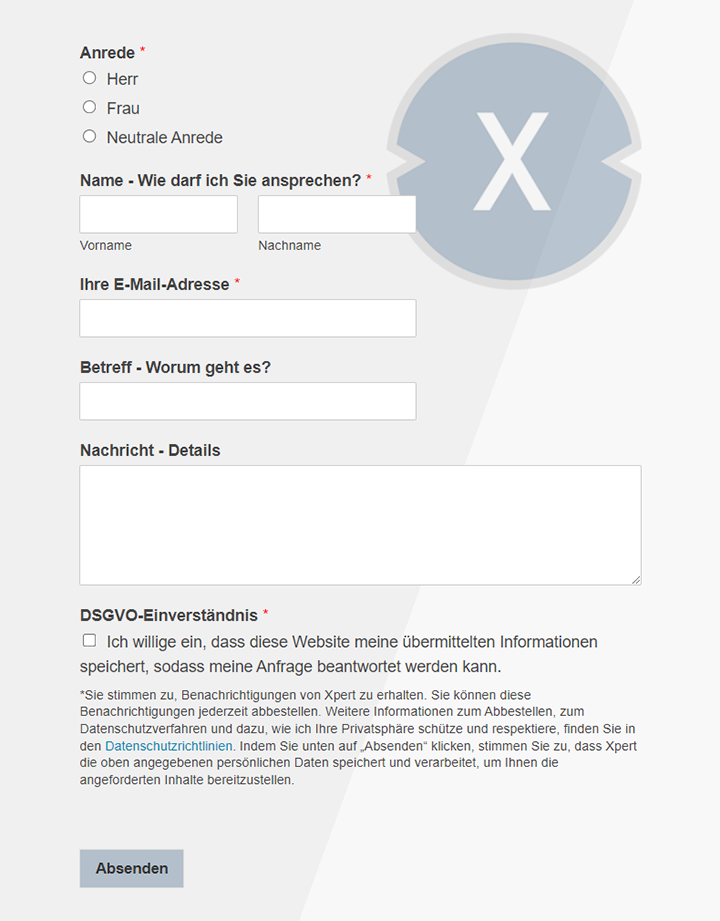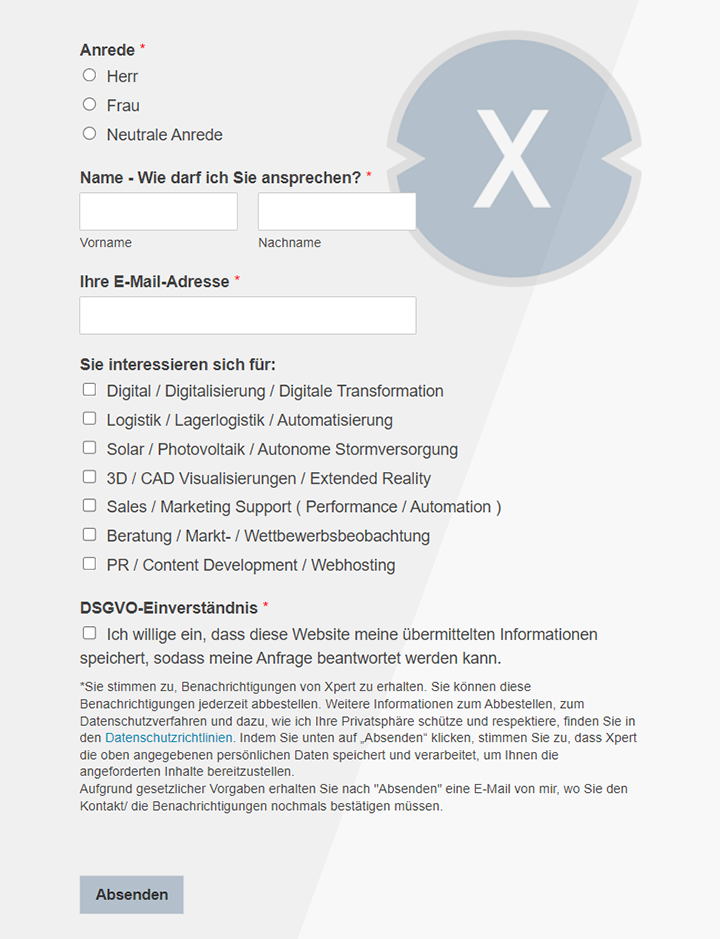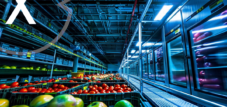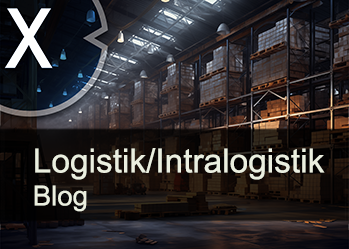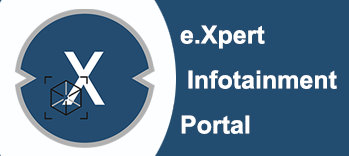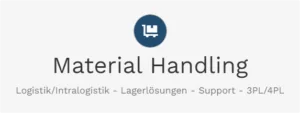The DNA evidence for your steak: This tech combination promises absolute guarantee of origin with blockchain technology
Xpert pre-release
Language selection 📢
Published on: July 13, 2025 / update from: July 13, 2025 - Author: Konrad Wolfenstein

The DNA evidence for your steak: This tech combination promises absolute guarantee of origin with blockchain technology-Image: Xpert.digital
Digital transformation of the meat industry: blockchain creates complete traceability
Veritas in Carne: an industry report on blockchain and the future of a sustainable meat chain
The global meat industry is at a crucial turning point, trapped between the pressure of an escalating global protein demand and an undeniable, multi -layered sustainability crisis. The ecological, social and economic deficits of the current production model- characterized by considerable greenhouse gas emissions, country and water deficiency, work exploitation and systemic inefficiency- are no longer portable. Gradually improvements have proven to be inadequate and require a paradigm shift towards radical transparency and accountability.
This article carries out a comprehensive analysis of blockchain technology as a potential basic pillar for this new paradigm. By creating a decentralized, unchangeable and transparent digital main book, the blockchain offers a fundamental infrastructure for transformation of the meat chain. It provides the technical means to create a “single source of truth” that enables the review of sustainability statements, ensuring ethical practices and the containment of business fraud.
We stand on the threshold of a revolutionary change in the logistics and transport industry thanks to the blockchain technology. As a digital main register, the blockchain promises the possibility of capturing transactions, eliminating intermediaries, reducing costs and preventing manipulations .
Suitable for:
- Global Logistics & Supply Chain: Business Blockchain instead of Bill of Lading (bill of lading document) / eCONBiL project
Our analysis shows that the potential of the technology is profound, but its implementation is associated with considerable challenges. This includes technological hurdles such as scalability and the "garbage-in, garbage-out" problem of data integrity, which can only be alleviated by the integration of supportive technologies such as the Internet of Things (IoT) and DNA tests. However, the socio-organizational barriers are even more powerful: the lack of industry-wide data standards, the difficulty, cooperation and fair incentives to ensure a fragmented chain of value, and complex governance issues.
Case studies from the practice of industry giants such as Walmart, JBS and Tyson Foods as well as innovators such as Beefledger show two parallel ways of introduction: one that is geared towards internal risk management and efficiency, and another who creates an added value through origin and trust. The future development indicates a convergence of these paths, driven by a strong feedback loop from increasing consumer demand for verifiable information, developing regulatory requirements such as the Food Safety Modernization Act of the FDA and accelerated market investments.
This article comes to the conclusion that blockchain is not a panacea. However, it is a decisive basic technology. Your final success is not measured by your cryptographic elegance, but on your ability to provide the trustworthy data layer, on which a more sustainable, more fairer and more resistant meat industry can be built up. We give strategic recommendations for all interest groups - from producers and processing to investors and regulatory authorities - in order to cope with the complexity of this transition and to use the transformative potential of the blockchain.
The need for a new paradigm in meat production
The global meat chain is a modern miracle of logistics and scope that secures the billions of people food and livelihood. But this success has a high price. The industry is still under immense pressure from two opposite forces: On the one hand, global meat consumption is continued in many regions even after 2025 through population growth and rising income, albeit no longer in the form of doubling, but with slow but constant growth. On the other hand, global consensus is growing that the current operating model of the meat industry is ecologically, socially and ethically not sustainable.
The ecological footprint of meat production remains an essential driver of climate change, design and water pollution. The industry is responsible for a significant share of greenhouse gas emissions and contributes to the overgrowth of land and water resources. Their social balance is still characterized by dangerous working conditions and negative effects on local communities. Economically, the structure of the industry remains complex and non -transparent, which means that inefficiency and susceptibility to large -scale fraud remain.
These challenges are not irrelevant; They are systemic and woven into the structure of a supply chain that is optimized for inexpensive, highly volume production. As a result, improvements and voluntary corporate commitments have proven to be inadequate in order to cope with the extent of the crisis. A fundamental paradigm shift - a departure from a system that builds on opaque processes and mediated trust is required towards a system that is based on verifiable data and radical transparency.
This article postulates that blockchain technology, a decentralized and unchangeable digital general book, represents a potential basic pillar for this new paradigm. By creating a common, unchangeable and transparent protocol of any transaction and every data point from the producer to the consumer, the blockchain offers the architectural foundation to restore trust and enforce accountability in the entire value chain. It promises to convert abstract claims of "sustainability" into verifiable evidence, reward responsible producers and to offer regulatory authorities an unprecedented transparency. This analysis will deal with the multi-layered sustainability crisis of the meat industry, deconstruct the core principles of blockchain technology and critically assess its real application, its limits and their future development in creating a more resistant and responsible future for meat production.
The sustainability deficit in the global meat chain
In order to understand the transformative potential of a proposed solution, it is initially necessary to diagnose the problem comprehensively. In its current form, the global meat chain has a significant deficit in sustainability in three interconnected columns: the ecological, social and economic. These challenges are not isolated failures, but systemic consequences of a model that has externalized its true costs for a long time.
The ecological footprint: a planetary stress
Greenhouse gas emissions (THG)
The environmental impact of industrial meat production is immense and well documented and significantly strain the finite resources of the planet. The meat industry is a main cause of climate change. Livestock breeding is responsible for a significant part of global anthropogenic THG emissions, with the estimates between 11 % and 20 %. The effects vary dramatic depending on the animal species; For example, beef production creates a carbon footprint, which is 8 to 10 times larger than that of chicken and up to 50 times larger than that of beans. This is largely due to the enteric fermentation in cattle, which releases huge amounts of methane, a greenhouse gas that is much more potent in its heat -storing ability than carbon dioxide.
Land and water use
The hunger for the industry is insatiable. About half of the entire habitable country on Earth is used for agriculture, and amazing 80 % of these agricultural areas are intended for cattle breeding, either directly as pasture or indirectly for the cultivation of feed plants. This extensive land use is often at the expense of natural ecosystems. The water footprint is similarly intolerable; The production of a single pound of beef can require up to 2,400 gallons of water, a frightening number in a world that is increasingly affected by water shortages.
Delay and loss of habitats
The expansion of the meat industry is a main driver of deforestation, especially in critical biomes such as the Amazon rainforest. Forests are cleared at an alarming pace to create pasture for cattle breeding and grow soy, a main component of animal feed. This practice not only releases immense amounts of carbon in the atmosphere, but also destroys biodiversity and drives thousands of plant and animal species to the brink of extinction.
Waste and pollution
The industrial model of meat production, which is based on factory farming companies (CAFOS), generates waste to an extent that overwhelm local ecosystems. Dumplings are often stored in huge open -air lagons that are susceptible to leaks and overflows and contaminate nearby soils and waterways with a toxic cocktail of antibiotics, bacteria, pesticides and heavy metals. In addition, the drainage of excess fertilizers and chemicals leads to nutrient pollution from the millions of hectares that are grown for animal feed, which lead to low -oxygen "death zones" in coastal waters and suffocate vital marine such as coral reefs. This linear, waste -intensive model is in the sharp contrast to the principles of a circular economy that would aim to upgrade by products and minimize waste streams.
The social and ethical swamp: a price for humans and animals
In addition to the ecological stress, the modern meat industry is affected with profound social and ethical problems that affect workers, communities and the animals themselves.
Work exploitation
The meat packaging was referred to as the "most dangerous factory job in America". The workforce consists disproportionately of population groups in need of protection, including low -income people People of Color and undocumented immigrants, who often have only a few other employment opportunities. These workers are exposed to a variety of dangers: low wages, dangerously fast processing lines to maximize throughput and constant handling of sharp tools and heavy machines. The injury rates are exceptionally high, with reports of an average of two amputations per week for workers in US meat factories between 2015 and 2017. The psychological stress is also serious, with studies on higher rates of anxiety, depression and post-traumatic stress disorders in slaughterhouse workers. In its most extreme forms, especially in global supply chains that come from regions such as Brazil, the industry was associated with practices of modern slavery and forced labor.
Rights of communities and indigenous peoples
The negative external effects of industrial animal husbandry are not limited to the factory walls. These companies are often located in or near marginalized communities, which then bear the main load of air and water pollution, the bad smells and the associated health problems such as respiratory diseases and higher rates of early deaths. This pattern represents a form of environmental right.
Animal welfare
The economic logic of industrial agriculture does not treat animals as a feelings, but as production units that are optimized for efficiency. This leads to systemic suffering to a massive extent. Billions of animals are raised annually under extreme keeping conditions, unable to live natural behaviors. They are routinely subjected to painful mutilation - such as entertain, castration and cups - often without anesthesia. The entire life cycle, from birth to transport to slaughter, is designed to minimize costs and maximize the yield, with animal welfare playing a subordinate role.
Economic inefficiencies and integrity gaps
The complexity and transparency that define the global meat chain also create significant economic challenges, including widespread fraud, inefficiency and injustice.
Food fraud and economically motivated falsification (EMA)
The long and winding path from the farm to the plate, with its many intermediate dealers and paper -based records, is an ideal environment for food fraud. This practice includes the deliberate substitution or falsification of food for economic enrichment and costs the global food industry an estimated $ 10 to $ 40 billion annually. Top -class incidents such as the 2013 European scandal, in which horse meat was widely sold as beef, have greatly undermined the trust of consumers. The problem is persistent; For example, the Australian beef industry has to struggle with massive challenges through fraudulent products that are sold under their brand names in the Lucrative Chinese market, which harms both the call and sales. EMA is not just an economic problem; It can also be serious health risks if not declared allergens or harmful substances are introduced.
Suitable for:
- Amazon Managed Blockchain with track and trace functions – e.g. B. for traceability of food poisoning
Inefficiencies and waste
Traditional supply chains work with isolated data systems. Each participant - farmer, processor, dealer, retailer - leads their own separate records, often on paper or in different digital formats. This fragmentation creates massive inefficiencies. It makes the trace of the source of a contamination outbreak a slow, tedious and imprecise process, which often leads to excessive wide and costly product recalls, in which secure foods are disposed of together with the contaminated articles. The lack of common, real -time transparency leads to poor inventory management, delays and increased food waste in the entire system.
Economic inequality
The current structure of the meat value chain is strongly centralized, with a few large corporations to practice an immense market power. This often leaves small producers and farmers in a precarious situation. They have difficulty competing with the scale effects of large industrial companies and only achieve a small fraction of the final price paid by the consumer, which contributes to economic and social inequalities in rural communities.
These ecological, social and economic challenges are not separate problems, but deeply linked. They are the foreseeable results of a system that is designed to put the production of cheap meat over everything else. The economic pressure for cheap protein promotes the industrial model of the cafos. This model, in turn, focuses on animals and their waste and directly causes heavy, local pollution. In order to process these animals on a large scale, fast, repetitive and dangerous factories are required, which leads to the exploitation of a workforce in need of protection. The opaque and complexity that enable this model of externalized costs also create the perfect conditions for the thrive of business fraud. Therefore, a sustainable solution can not only look at a dimension in isolation. It must confront the basic economic model of the industry. A technology such as the blockchain, which suggests radical, systemic transparency, is predestined to do so by questioning the status quo and making the true production costs visible and accountable.
Blockchain as a basic technology for the transformation of the supply chain
In order to fix the systemic deficiencies of the meat chain, a technology is required that can fundamentally change how information is recorded, shared and classified as trustworthy. The blockchain technology, often described as a decentralized digital high-capitory, offers a new architecture that was designed exactly for this purpose. It is not just a gradual improvement of existing databases; It is a new technological paradigm for creating and maintaining a common, safe and uniform truth register between several, often suspicious parties.
Basic principles: the triad of trust
The strength of blockchain technology results from the interaction of three core principles that together incorporate trust and integrity into a digital system.
decentralization
In contrast to traditional centralized databases in which a single entity (such as a company or a bank) has and controls the data, a blockchain ledger is often referred to, distributed and replicated via a network of computers. Each participant in the network has a copy of the Ledger. This decentralized structure eliminates every single failure or control point. No individual actor can change the records unilaterally, shut down the system or censor the transactions, which makes the network very resistant and robust.
immutability
This principle ensures that data as soon as they have been entered in the blockchain cannot be changed or deleted retrospectively. Transactions are grouped in "blocks", and each new block is cryptographically linked to the previous one, which creates a chronological and unbreakable "chain". Any attempt to manipulate a recorded block would change its cryptographic signature, which would invalidate all subsequent blocks in the chain. Such a change would be recognized and rejected immediately by the rest of the network. This function creates a permanent and manipulation -proof test lane of every transaction that has ever taken place in the network. If a mistake is made, it cannot be deleted; A new transaction must be created to correct the error, and both transactions remain visible, which guarantees a complete history.
transparency
Although blockchain networks can be configured with different data protection levels (e.g. publicly, private or private or subject to approval), the core principle of transparency means that all authorized participants in the network can access the same version of the ledger in real time. This ensures that every stakeholder - from the farmer to the regulator to the consumer - starts from a "single source of truth". This common visibility eliminates the information silos, which plague traditional supply chains, promotes accountability and enables the independent review of data by each participant.
Architectural key components
Several technological key components underpin the principles of decentralization, unchangeable and transparency.
Distributed-Ledger technology (DLT)
This is the basic concept. DLT refers to every database that is divided in a consensus -based manner and synchronized across several locations, institutions or geographical regions. Blockchain is the best known type of DLT. Their main advantage is that they record transactions only once and thus eliminates the massive duplication and constant comparison needs, which is characteristic of traditional business networks in which each party leads its own separate main register.
Cryptographic hazhing
This is the mathematical function that ensures the security and linking of the blocks. A hash is a unique, fixed string that serves as a digital fingerprint for a data record. Each block in the chain contains its own unique hash and the hash of the previous block. This creates the safe, sequential chain. Even a tiny change in the data within a block would create a completely different hash, break the chain and signal manipulation.
Consensus mechanisms
In a decentralized system without central authority, a protocol is required so that the network participants can agree on which transactions are valid and should be added to the Ledger. This is the role of the consensus mechanism. The best known is the proof-of-work (Pow), in which "Miner" compete to solve complex arithmetic puzzles. Another known mechanism is the Proof-of-Stake (POS), in which "validators" are selected to create new blocks based on the amount of cryptocurrency that you have "stored" as security. These mechanisms enable the network to maintain its integrity and to agree on a single version of the truth.
Smart contracts
These are one of the most powerful applications in blockchain technology for supply chains. A smart contract is essentially a program stored on the blockchain, which is carried out automatically when specified conditions are met in advance. The conditions of an agreement are written directly to the code. For example, a smart contract could be programmed in such a way that it automatically releases the payment of a retailer to a farmer as soon as an IoT sensor confirms that delivery in the distribution center has arrived within the correct temperature range. By automating such processes, smart contracts reduce transaction costs, eliminate delays, eliminate the need for intermediaries such as banks or trustees and enforce compliance with agreed rules.
The creation of a "single source of truth"
The combination of these principles and components creates what is often called the "only source of truth" for the supply chain. The truth is fragmented in a traditional model. The farmer has his version of the truth in his notes, the processor of his and the retailers. Discrepancies are common and their solution is time -consuming and expensive.
Blockchain technology replaces this fragmented reality with a single, common and trustworthy captain. Each participant with the corresponding permissions can see the same data at the same time, knowing that it is a complete and unchangeable recording of events. This common visibility creates an environmental accountability.
It is crucial to understand that blockchain is not just a more efficient database; It is described better as "institutional technology" or "trust engine". Their main function is to create trust in environments in which there is no or expensive to establish. In a conventional supply chain, trust is conveyed by intermediaries - banks, lawyers, examiners, certifiers - or slowly built up with personal relationships. This is a slow, costly and often fragile process. Blockchain technology automatically and externalizes this function of trust formation. The cryptographic certainty of the unchangeable ledger guarantees the integrity of past events, while smart contracts automate the enforcement of future agreements based on this verified data. This realignment of the purpose of the technology is crucial. The aim of implementing blockchain is not only to manage data more efficiently, but to fundamentally restructure the relationships between the supply chain partners by minimizing friction, reducing the counter -party risk and reducing the power and costs of intermediaries. This has profound effects on the business models, cost structures and power dynamics of the entire meat industry.
🎯🎯🎯 Benefit from Xpert.Digital's extensive, fivefold expertise in a comprehensive service package | R&D, XR, PR & SEM

AI & XR 3D Rendering Machine: Fivefold expertise from Xpert.Digital in a comprehensive service package, R&D XR, PR & SEM - Image: Xpert.Digital
Xpert.Digital has in-depth knowledge of various industries. This allows us to develop tailor-made strategies that are tailored precisely to the requirements and challenges of your specific market segment. By continually analyzing market trends and following industry developments, we can act with foresight and offer innovative solutions. Through the combination of experience and knowledge, we generate added value and give our customers a decisive competitive advantage.
More about it here:
Digital transformation of the meat industry: Blockchain as a key to sustainable production and consumer protection
The convergence: application of blockchain to the sustainability of the meat chain
The true potential of blockchain technology is realized if your core skills are applied directly to the specific, deeply rooted sustainability challenges of the meat chain. By creating an unchangeable and transparent protocol of the trip of a product, the blockchain vague sustainability statements can convert into verifiable data points and thus promote a new level of accountability via the ecological, social and economic dimensions of the industry.
Suitable for:
- What specific advantages does blockchain offer compared to traditional cold chain monitoring methods?
Strengthening ecological accountability
The environmental damage caused by the meat industry is largely a result of its lack of transparency. The blockchain offers a powerful tool to bring these hidden effects to light and to create mechanisms for accounting.
Verifiable claims
Consumers are increasingly skeptical about vague marketing terms such as "sustainably raised" or "environmentally friendly". The blockchain offers a mechanism to pass from mere labels to testable evidence. For example, an assertion such as “deformation-free” can be underpinned by linking a certain beef spears with GPS data from IoT-capable ear stewards, which prove that the animals have been raised on established pasture and not on recently cleared surfaces. Likewise, a "grass -fed" claim can be verified by unchangeable records that show the location of the animal in the pasture throughout his life. This creates a direct, unchangeable connection between the physical product and its environmental detection, a process that is far more robust than traditional paper -based certification.
Make sustainability measurable: Blockchain transforms marketing promises into verifiable data in the meat industry
Resource and emission tracking
The technology can serve as a comprehensive general book for the ecological footprint of a product. Data on resource inserts, such as the used water volume or type and amount of the feed, can be recorded in any phase. This enables the calculation and transparent reporting over the entire carbon and water footprint of a product. Such data are invaluable for companies with emission reduction destinations, for compliance with new environmental regulations and to provide consumers the clear information they need for conscious purchase decisions.
Incentives for sustainable practices
By making sustainable practices verifiable and transparent, the blockchain can underpin new economic models that reward ecological sense of responsibility. For example, a premium price for demonstrably “low-carbon” beef for the consumer becomes more justified and trustworthy. In addition, new concepts such as plant -based tokens could be created in which farmers are rewarded directly with digital assets for achieving specific, verified environmental results, such as: B. the carbon binding in their grazing countries or reducing water consumption. This creates a direct financial incentive for the producers to introduce more sustainable methods.
Promotion of social justice and ethical security
The social grievances of the meat industry, from work exploitation to animal welfare concerns, exist in the shade of complex and non -transparent supply chains. The blockchain can throw light on these practices and create pressure for improvements.
Review of fair working conditions
Exercising work practices, including the use of forced or "slave work", are a dark reality in parts of the global meat chain. The blockchain offers a tool for checking and accountability. The groundbreaking platform of JBS-Brazil, which was developed to monitor their suppliers in compliance with socio-ecological standards, including the ban on slave work, is a prime example of this application. By creating safe and unchangeable records of employment contracts, wage payments and independent audits of working conditions, the technology offers a mechanism to hold companies for human rights standards in their huge networks.
Ensuring animal welfare
Allegations such as "species-appropriate attitude" or "antibiotics" are central to the marketing of many premium meat products, but they are often difficult to check for consumers. The blockchain can record important animal welfare indicators throughout the life of an animal. Data points such as the space per animal, health files, detailed use of any antibiotic use, and the conditions during transport can be logged in the unchangeable main register. This information could then be made accessible to consumers via a simple QR code scan on the end product so that they can check the ethical claims of the brand and build up a deeper level of trust.
Restoration of economic trust and efficiency
The economic benefit of the blockchain in the meat chain focuses on the containment of fraud, reducing inefficiencies and building direct trust in the end consumer.
Combating food fraud
This remains one of the most convincing and immediate applications for technology. The non -transparency of the current system makes it vulnerable to economically motivated falsifications. By creating a complete, consistent and manipulation -proof protocol of the product delivery chain, the blockchain makes it exceptionally difficult to smuggle fraudulent or fake products unnoticed. Each handover is recorded and verified. A classic example is the Beefledger project that was specially developed to use the blockchain to ensure the authenticity of premium beef from Australia that is exported to the Chinese market-a market on which food fraud is a major problem for consumers.
Rationalization of transactions and cost reduction
The dependence on paper -based processes and intermediaries such as banks and examiners causes considerable costs and friction losses in the supply chain. Smart contracts can automate many of these functions. For example, a payment from a processor to a fattening operation can be triggered automatically as soon as the system verified the weight and quality class of a delivered beef spear. This reduces paperwork, eliminates payment delays and lowers the fees for intermediaries, which leads to lower overall transaction costs and improved operational efficiency.
Strengthening consumers and building brand confidence
Perhaps the most transformative application is the creation of a direct connection between the producer and the consumer. By scanning a QR code on a steak packaging, a consumer could potentially access the blockchain entry and see the entire history of this product: the farm on which the animal grew up, photos or videos of the farm, its health records, the processing date and his journey through the supply chain. This level of radical transparency is a powerful tool for building up brand loyalty and consumer confidence. It relocates the marketing slogan's trust on the packaging to the checkable data in the main register.
The convergence of blockchain and the meat chain is a fundamental change. It moves the industry from a world abstract "claims" to a world of verifiable "attributes". An assertion of how "sustainably raised" or "ethically procured" is currently a marketing label that is often supported by an opaque and costly certification process to which consumers should trust. The blockchain changes this dynamic. An assertion like "organic" is no longer just a sticker; It becomes a number of unchangeable, testable transactions in a common capacity-proof of the purchase of organic feed, certification of land use, records of antibiotic veterinary care and so on. Trust is no longer placed in the brand's marketing department, but into the mathematical and cryptographic integrity of the common data. This has the potential to completely redesign the type of branding and competition in the meat industry and to force a change from the most appealing claims to the most robust and transparent evidence.
Market implementations and case studies
The application of blockchain technology in the meat chain has developed from theoretical discussions to practical, real implementations. These initiatives are promoted both by established industry giants that want to minimize risks and improve efficiency, as well as from agile startups that want to create new promises of values that are based on trust and origin. An investigation of these case studies shows the specific ways in which the technology is used, and the diverse business goals that they pursue.
Industry giants as a pioneer: the advance for broad acceptance
Large, multinational corporations are at the top of the research of blockchain and use their skills, especially for large -scale food safety, compliance and optimization of the supply chain.
IBM Food Trust Consortium
This is probably the most important efforts to cooperate in this area. Led by IBM, the consortium includes a list of global industry leaders such as Walmart, Tyson Foods, Nestlé and Dole. The initiative uses the IBM blockchain platform subject to approval to create a safe environment in which trustworthy partners can exchange data. The main objectives are the improvement of food safety, better traceability for faster recalls and increasing the general efficiency of the supply chain.
Walmart
As an important founding member of the IBM Food Trust, Walmart was a pioneer when using blockchain. The retail giant has carried out a lot noted and successful pilot projects, including the persecution of pork in China and mangoes in the United States. In the mango pilot project, the time required to trace the origin of the fruit from business to the farm was drastically reduced from seven days to only 2.2 seconds. Based on these successes, Walmart took decisive steps and obliged all of its suppliers of fresh leafy vegetables to join his blockchain network in order to enable quick tracking in the event of contamination. The company has also initiated a project to create a fully traceable Angus beef bleed chain, which combines cattle breeders, fattening companies, packers and retailers on a single platform.
JBS
The world's largest meat processor has accepted the blockchain through several strategic initiatives. JBS Australia has implemented a “Paddock-to-Primals” traceability program for its premium beef King Island Beef that delivers detailed origin information. Even more ambitious, JBS-Brazil has started his own “transparent cattle breeding platform”. This blockchain-based system is intended to monitor the huge and complex network of cattle suppliers of the company to socio-ecological conformity, with a special focus on combating illegal design in the Amazon and the extermination of forced labor or "slave work" in its supply chain-a direct reaction to the pressure from investors and NGOs.
Tyson Foods
As another important member of the IBM consortium, Tyson also used the blockchain for his own branded products. The company uses the technology to provide traceability for its lines Open Prairie® Natural Pork and Open Prairie® Natural Angus Beef and to assure consumers that the products can be traced back to the specific farms on which the animals are born and grew up.
Cargill
Cargill has demonstrated the consumer-oriented potential of the blockchain with its Honeysuckle White® turkeys. Through a simple code on the product packaging, consumers can access a website that tells the history of their specific turkey, including the location of the independent family business that raised them, and even photos of the farm, which creates a strong connection between producer and consumer.
Innovators and startups: niche solutions and new models
While industry giants focus on scaling and efficiency, a number of startups have arisen that tackle specific problems and create new, premium market segments based on blockchain verified trust.
Beefledger
This Australian startup offers an informative case study both for potential and the dangers of blockchain implementation.
Problem: Beefledger was founded to tackle the rampant food fraud and security concerns in connection with premium beef exported to China. Chinese consumers, suspicious of fake products, lost confidence in the authenticity of imported beef, which led to a loss of sales and reputation damage for legitimate Australian brands.
Solution: The company developed a blockchain platform to provide a certified, unchangeable detection of the entire journey of beef from Australian paddock to Chinese consumers. This created a transparent and verifiable supply chain that should restore trust.
Consumer insights: A survey carried out in 2019 for Beefledger provided decisive market information. It showed that Chinese consumers were not only interested in this technology, but were also ready to pay a significant surcharge-between 31 and 57 Yuan more for a 150-gram steak-for beef, the origin and trip through the blockchain were validated. The survey also showed that the most important evidence for consumers was checkable packaging and expiry data as well as the detection of uninterrupted cold chain integrity.
Challenges: Despite his innovative approach, Beefledger was exposed to strong counter -winds. The project was significantly affected by the logistical disorders of the Covid 19 pandemic and the severe deterioration in geopolitical relationships between Australia and China that disturbed the trade currents. This underlines the susceptibility of even the most advanced technological solutions to external macroeconomic and political shocks.
Beefchain®
This initiative based in Wyoming, USA, focuses on the domestic premium market. She uses blockchain and QR codes to enable a consortium of cattle breeders to track its cattle from the "pasture to the meat counter". The aim is to provide an undeniable proof of origin for high -quality, America -raised beef so that the cattle breeders can achieve an additional charge for their products.
Ecotrace
This Brazilian startup offers a continuous trial platform especially for the cattle and poultry sector. A main focus of Ecotrace is on the cooperation with the cooling and transport industry to ensure that a seamless and verifiable detection of the cold chain is conducted on the blockchain, a decisive factor for the safety and quality of meat.
The crucial connection: integration of the DNA traceability
A crucial weak point in every blockchain-based trial system is the connection between the physical product and its digital data record. The blockchain can unchangeable data about a certain animal, but it cannot prove on its own that the piece of meat actually comes from this animal in a certain packaging. This is the "garbage-in, garbage-out" problem, in which the physical asset can be exchanged or falsified before its data is entered in the general book.
In order to solve this, leading initiatives integrate DNA tests as the ultimate anchor in physical-digital identity. Companies such as Tyson and the national Irish traceability program for beef have promoted this approach. The process includes the removal of a DNA sample from an animal in the slaughterhouse and the combination of its unique genetic profile with its data record on the blockchain. This creates a final, scientific connection. A retailer, a supervisory authority or even a consumer could then have a sample tested from an end product and compare your DNA with the blockchain data set in order to provide absolute, irrefutable proof of origin. This integration of biotechnology and information technology represents the gold standard for the integrity of the supply chain and closes the last gap in the chain of trust.
A clear strategic divergence can be seen on the market. Industry giants such as Walmart and JBS use the blockchain primarily as a powerful internal tool for risk management, compliance with food safety and large -scale logistical optimization. For you, the return on investment is calculated in reduced callback costs and improved operational efficiency. In contrast, startups such as Beefledger and Beefchain are based on business models that are based on another promise of values: that consumers will pay a surcharge for the verifiable trust and the origin that the blockchain offers, especially in markets plagued by fraud, or for products that are marketed due to their unique history of origin. This indicates two different, but parallel paths for the introduction of the blockchain in the meat industry: a "compliance and efficiency path" that is powered by the size of the company, and a "premiumization and trust path" that is powered by consumer-oriented brands. The long -term maturation of the technology will probably lead to a convergence of these two paths, in which the efficiency gains required by the giants are combined with the radical transparency promoted by the innovators. The integration of DNA tests is the summit of the "trust path" and offers a level of review that transforms a simple data log into a scientifically supported guarantee.
Critical analysis of the implementation: hurdles and limits
Although the potential of the blockchain to revolutionize the meat chain is significant, its practical implementation is associated with considerable hurdles. A sober analysis shows that the path to broad acceptance is hindered by technological bottlenecks, basic economic contradictions as well as complex human and organizational challenges. Overcoming these limits is just as important as the development of the technology itself.
Technological and scalability challenges: the service
The core architecture of blockchain technology has inherent performance compromises, which are particularly challenging for the data-intensive surroundings of a global supply chain.
The scalability trilemma
As is known, blockchain systems are restricted by a "trilemma" that forces a compromise between three desirable properties: decentralization, security and scalability. Early public blockchains such as Bitcoin prioritized decentralization and security, which led to a very low scalability. You can only process one handful of transactions per second, a rate that is generated for the millions of data points that are generated every minute in a complex supply chain with iOt sensors and real-time tracking.
Data storage
The design of a blockchain, in which the main book grows with every transaction and a complete copy is stored by many participants, is a significant challenge for data storage. This would lead to a "data explosion". The storage of all this information directly on the main blockchain ("on-chain") would be unaffectedly expensive and technically impractical.
Possible solutions
The blockchain development group is actively working on solutions to fix these performance problems. These can be roughly categorized as:
Layer-1 (on-chain) solutions: These include the modification of the core protocol of the blockchain itself. Examples are shading that the blockchain database divides into smaller, more manageable segments that can process transactions in parallel, and the introduction of more efficient consensus mechanisms (see below).
Layer-2 (off-chain) solutions: These solutions are crucial to make the blockchain usable for supply chains. They work by processing the vast majority of the transactions "OFF" of the main blockchain in a secondary shift and only recording periodic summaries or evidence back to the main chain for safety. This increases the transaction throughput drastically and lowers the costs. Important Layer-2 technologies are rollups (which bundle many transactions in a single evidence), Channels and Sidecins.
Hybrid models: Many corporate solutions will probably use a hybrid approach in which most daily supply chain transactions are carried out on a quick, private or approval blockchain, while periodically, cryptographic evidence of the condition of this private chain is "anchored" on a highly secure public blockchain for ultimate testability and unchangeable.
The energy silemma: a contradiction in sustainability
One of the most important reviews of blockchain technology is its high energy consumption, which is a direct contradiction if the technology is proposed as a tool for sustainability.
Proof-of-work (Pow)
The original consensus mechanism, the Bitcoin and until recently drives Ethereum, is the main culprit. Pow is based on a global network of "miners" that compete to solve computing -intensive puzzles. This process consumes huge amounts of electricity due to the design, whereby the annual energy consumption of the Bitcoin network corresponds to the whole countries such as Argentina or the Netherlands. The use of a pow-based blockchain to pursue the sustainability of a meat product would be a profound and unacceptable hypocrisy.
Energy -efficient alternatives
Fortunately, Pow is not the only option, and the industry quickly moves towards more sustainable alternatives.
Proof-of-Stake (POS): This is the leading energy-efficient consensus mechanism. Instead of the calculating mining, POS systems select "Validators" to create and approved new blocks based on the amount of the network of cryptocurrency of the network, which they are willing to "stake" as security. This eliminates the competitive, energy -intensive guessel. The transition from the Ethereum network from Pow to POS in 2022 led to a reduction in its energy consumption by over 99.9 %, a groundbreaking performance for the industry.
Proof-of-Authority (POA): This mechanism is particularly suitable for private or consortium blockchains that are common in corporate applications for supply chains. In a POA system, transactions are validated by a small, pre-tested group of trustworthy nodes (the "authorities"). Since it does not require a widespread competition or complex calculations, its energy consumption is minimal.
The choice of consensus mechanism is a decisive strategic decision for every serious application of blockchain in a sustainable meat chain. The use of Pow is not viable, while POS and PoA offer highly efficient and sustainable alternatives.
Comparative analysis of blockchain consensus mechanisms
The comparative analysis of blockchain consensus mechanisms shows significant differences in its suitability for the meat chain. Proof-of-work (Pow) is based on the principle that miners have to solve complex arithmetic puzzles to validate blocks. This mechanism is characterized by extremely high energy consumption and only offers a low scalability of around 7 transactions per second, as the Bitcoin example shows. The safety model is based on immense computing power and is safe against 51%attacks due to the high costs. Due to the high energy consumption that contradicts the sustainability goals, Pow is unsuitable for the meat chain.
Proof-of-Stake (POS) works differently: Validators are selected based on the amount of cryptocurrency that “staken” as security. This approach consumes over 99% less energy than Pow and offers high scalability with thousands of transactions per second. Security is based on economic use, with attackers risking the loss of their clocked collateral. POS proves to be very suitable for the meat chain because it offers a sustainable and scalable alternative for public and private networks.
Proof-of-Authority (POA) relies on a small number of pre-tested, trustworthy entities as authorities that validate transactions. The energy consumption is minimal, while scalability is very high. The security model is based on the reputation and identity of the validators, with trust in known entities. PoA is very suitable for consortium supply chains that are known and trustworthy.
Delegated Proof-of-Stake (DPOS) combines various approaches: Token owners choose a small number of delegates that validate transactions in their name. The energy consumption is very low and the scalability is very high. The security model represents a mix of economic use and democratic choice, but is more centralized than POS. DPOS is suitable for applications that require a quick throughput, but brings with it some centralization compromises.
The "Garbage-in, Garbage-Out" problem: the oracle challenge
The unchangeability of a blockchain is both its greatest strength and a critical weak point. The main register ensures the received data perfectly and permanently, but has no inherent ability to know whether this data was correct or truthful at the time of input. If an agricultural worker manually enters the wrong data - for example, claims that a batch of conventionally raised chickens are "organic" - the blockchain will faithfully record and secure this lie. This is the "garbage-in, garbage-out" (gigo) principle, and it represents a fundamental challenge for the integrity of every blockchain-based system.
This problem is known as the oracle problem: the challenge of getting reliable, trustworthy data from the real world (off-chain) on the blockchain (on-chain). The credibility of the entire system is only as strong as its "oracle" - the sources of its data.
Reduction strategies
The solution to the oracle problem is not in the blockchain itself, but in its integration with other technologies that can automate and verify the data input in order to reduce the dependence on fallible human input.
Internet of Things (IoT)
This is the most critical integration. The use of automated sensors for recording and direct transfer of data to blockchain minimizes the risk of human errors or deliberate manipulation. Manipulation-proof IoT sensors can automatically record and log over critical data points such as the temperature of a cooling truck, the GPS location of a beef flock or the humidity in a warehouse.
DNA tests
As detailed in section 4.3, the integration of the DNA analysis offers a definitive, scientific connection between the physical meat product and its digital identity on the blockchain. This offers the strongest possible protection against physical substitution or fraud.
Third-party audits
The system can be designed in such a way that it includes data input from trustworthy, independent third-party auditors that physically check practices on site (e.g. animal welfare standards, biological land use) and confirm them on the blockchain.
Inter-company and governance barriers: the human factor
In addition to the technological hurdles, the most powerful barriers for the introduction of often social, economic and political nature are.
Data standardization
The global meat chain is a patchwork of countless actors in numerous countries, each of whom use their own internal systems, processes and data formats. There is no universally accepted standard for which data must be collected (e.g. how to classify a slaughter body, which defines "free -range") or how to format. This lack of standardization makes the creation of an interoperable blockchain system that can be used by all participants, a monumental challenge.
Cooperation and incentives
A blockchain is a network technology; Their value is directly proportional to the number of participants. However, it is a big hurdle to convince every player in a long and fragmented supply chain to take over the technology. Small farmers in developing countries, for example, may lack resources, training or technical infrastructure to participate. The question of incentives is more fundamental. Why should a farmer bear the costs and effort of the careful data input at the beginning of the chain if the financial surcharge for the "traceable" end product is completely recorded by the brand or the retailer at the end of the chain? Without fair, transparent and often automated (via smart contracts) incentive structures, acceptance will fail on the decisive "first mile".
Data protection vs. transparency
While transparency is an important advantage, the participants of the supply chain are understandably protectively protecting compared to commercially sensitive information such as supplier lists, prices and transaction volume. The design of a system that offers sufficient transparency to satisfy consumers and regulatory authorities without disclosing proprietary data that could endanger the competitive position of a company is a delicate balancing act. Blockchains that are subject to approval, in which only authorized parties can view certain data, offer a solution, but this can be considered with regard to centralization and control by the dominant actors that determine the rules for the network.
Ultimately, the biggest obstacles to the introduction of the blockchain in the meat chain are not purely technical in nature. The technological challenges such as scalability and energy consumption have plausible and emerging solutions. The much more unsolvable problems lie in the human and organizational layers. A development team can design a highly scalable, energy-efficient proof-of-stake blockchain system. What you cannot do is to force a group of competing meat packaging companies to agree on a single, uniform data standard for the slaughter body classification. You cannot force a large retailer to share the surcharge that he demands for "traceable beef" to share fairly with the hundreds of small farmers who had to enter the data. And, by code alone, you cannot prevent a worker from entering incorrect data, without a robust system of automated sensors or external audits to solve the oracle problem. This leads to a crucial conclusion: A successful blockchain implementation is less about using the "best" technology rather than creating a successful ecosystem. This requires the difficult work to establish strong governance bodies, create fair and transparent economic incentives, to invest in additional technologies such as IoT and to promote unprecedented industry-wide cooperation. Initiatives such as the Blockchain toolkit of the World Economic Forum are direct recognition of this reality and focus on creating neutral platforms and governance frames in order to solve this complex challenge at ecosystem level.
Our recommendation: 🌍 Limitless reach 🔗 Networked 🌐 Multilingual 💪 Strong sales: 💡 Authentic with strategy 🚀 Innovation meets 🧠 Intuition
At a time when a company's digital presence determines its success, the challenge is how to make this presence authentic, individual and far-reaching. Xpert.Digital offers an innovative solution that positions itself as an intersection between an industry hub, a blog and a brand ambassador. It combines the advantages of communication and sales channels in a single platform and enables publication in 18 different languages. The cooperation with partner portals and the possibility of publishing articles on Google News and a press distribution list with around 8,000 journalists and readers maximize the reach and visibility of the content. This represents an essential factor in external sales & marketing (SMarketing).
More about it here:
Blockchain revolutionizes meat chains: Why the traceability is more complex than with coffee and vegetables
Comparative analysis: The meat chain compared to other agricultural sectors
In order to fully appreciate the unique challenges and opportunities of the implementation of blockchain in the meat industry, it is revealing to compare your supply chain to those of other agricultural sectors in which the technology was used, such as coffee, seafood and fruit/vegetables. This comparative analysis shows that the specific properties of the product itself-in particular its transformation and mixing-are the main determinants for the complexity and the costs of a blockchain solution.
Suitable for:
- Cold chain logistics with blockchain as a game changer for food and pharmaceuticals – traditional control procedures outdated
Unique complexities of the meat chain
The path of the meat from the farm to the plate is characterized by several complexities, which make traceability a much greater challenge than many other foods.
Transformation and mixing
This is the most basic challenge. A coffee bean, a lettuce head or a fish fillet mostly keep your discrete identity throughout the entire supply chain. In stark contrast to this, a single living animal, such as a cow, is converted into a variety of different products - various steak cuts, roasts and minced meat as well as by -products such as skins for leather. During processing, especially for products such as minced meat or sausages, meat is often mixed by hundreds or even thousands of different animals. This physical "encryption" of identity makes it impossible to attribute a pack of minced meat with a simple track-and-trace system to a single animal. Without advanced and costly solutions such as DNA tagging, the traceability track for these products ends in fact at the batch level of the slaughterhouse.
Long and complex life cycles
The life cycle of farm animals is considerably longer and more fragmented than that of most crops. An animal can go through several possessions- a breeder, a breeder, a mast farm and finally a butcher- before it even enters the processing and sales phase. Each of these transfers represents a critical point at which data must be recorded and transferred exactly, which increases the potential for data loss or errors during the long life of the animal.
Integrity of the cold chain
As a slightly perishable product, meat requires an uninterrupted, temperature -controlled environment - the "cold chain" - from the moment of processing to reaching the consumer. Checking the integrity of this cold chain is not just a question of quality, but a critical requirement for food safety. This makes the integration of IoT temperature sensors not only an add-on, but also a fundamental need for a credible meat traceability system, which adds an additional layer of technological complexity and costs.
Fragmented "first mile"
While the processing and retail levels of the meat industry are dominated by large, powerful corporations, the "first mile" of the supply chain- the farms and ranches on which the animals are born and raised- is often very fragmented. It consists of numerous small, independent producers to which capital, technical expertise or incentive may lack demanding data recording technologies. This reflects the "small farmer problem", which can also be observed in other agricultural sectors, and represents a significant obstacle to achieving real end-to-end traceability.
Cross -sectoral knowledge: teachings from coffee, seafood and fruit/vegetables
The examination of blockchain applications in other agricultural sectors provides valuable teachings and comparison points for the meat industry.
Coffee
The coffee chain shares the critical challenge to strengthen and integrate small farmers that produce most of the worldwide coffee. Blockchain projects in this area, such as those initiated by Farmer Connect and Moyee Coffee, have focused greatly to ensure fair and prompt payments to the farmers and to provide consumers of stories of origin for pure beans. An important hurdle that was identified in the coffee sector is the unequal distribution of the value and the immense, which is exercised by a few large dealers and roasters. This provides a direct teaching for the meat industry: a traceability system that does not take into account the economic fairness and incentives for the primary producer will probably not achieve the necessary acceptance and data quality at the source.
seafood
The seafood industry, especially in high -quality and frequently fake products such as tuna, was an important test field for the use of blockchain for fighting fraud and reviewing claims on legal and sustainable fishing practices. The case study from Provenance, which thuna persecuted from Indonesian fishermen to consumers, showed the importance of building an ecosystem that not only comprises companies, but also certification bodies and NGOs for validating allegations. The Intel project for the use of Hyperledger Sawtooth for the traceability of seafood emphasized the performance of the integration of blockchain with sensory equipment for monitoring critical conditions such as temperature during storage and transport, a direct parallel to the requirements for the cold chain for meat.
Fruit & vegetables
The main driver for the introduction of blockchain in the freshware sector was food safety and the need for quick recalls. Walmart's well-known mandate for his suppliers of leaf vegetables to join his blockchain network was a direct reaction to repeated E. coli eruptions. The most important metric of success here is the speed - reducing the tracection times from days to seconds. The implementation is generally less complex than with meat, since fruit and vegetable items are typically not transformed or mixed to the same extent. However, the challenge of fruit and vegetables is often the low margin of the products, which can make cost-benefit analysis for the implementation of blockchain difficult for anything but high-risk or high-quality special items.
This comparative analysis leads to a crucial conclusion: The success and complexity of a blockchain solution in a certain agricultural supply chain are, conversely, proportional to the degree of physical product transformation and mixing. The more a product maintains its discrete identity from its origin to the end consumer, the easier and cheaper the implementation of an uncomplicated and effective blockchain traceability system. A batch of coffees can be followed as a unit. A lettuce head remains a lettuce head. However, an ox becomes hundreds of different products, which are often mixed with products from other oxen to create new articles such as minced meat. This physical disagregation and re-aggregation of identity is the greatest technical challenge for the traceability of meat. This implies that a simple "track-and-trace" blockchain model is inadequate for a significant part of the meat market. In order to achieve a real, verifiable farm-to-fork traceability for processed and mixed meat products, more advanced and more expensive solutions that can restore identity at the point of sales-namely the integration of DNA tests-are not just an improvement, but a necessity. This reality places the technological and economic hurdles for a comprehensive introduction of the blockchain in the meat industry at a significantly higher level than many of their agricultural counterparts.
Future development: market dynamics, consumer behavior and regulatory evolution
The future of the blockchain in the meat chain will be shaped by the dynamic interaction of market forces, developing consumer expectations and an increasingly demanding regulatory landscape. The current trend indicates an acceleration of the introduction, which makes the technology from a niche characteristic of premium products a fundamental requirement for market access and operational integrity.
Market forecast and investment trends
Despite the considerable implementation challenges, the market outlook for blockchain in the broader agricultural and food sector is exceptionally strong, which signals a considerable confidence in the long-term promise of value in technology.
Market growth forecast
Forecasts for the global market for blockchain in the agricultural and grocery chain are consistently predicted by explosive growth. While specific figures vary between the market research companies, the consensus indicates a strong upward trend. Forecasts include growth of around $ 133 million in 2020 to around $ 948 million by 2025 and $ 232 million in 2024 to almost $ 985 million by 2030. Other reports predict an even more aggressive growth, with some estimates by 2030/2033 even $ 7.4 billion. Regardless of the exact numbers, these forecasts reflect a robust average annual growth rate (CAGR) in the range of 27 % to 48 %, which indicates a market that quickly moves from childhood to a high -growth phase.
Important market driver
This fast growth is not speculative; It is underpinned by fundamental changes in the industry. The main drivers are the increasing consumer demand for food safety and transparency, the urgent need for more efficient and more resistant supply chains and an increase in risk capital and company investments in agricultural technology (AG-Tech). The global covid-19 pandemic acted as a catalyst, which significantly revealed the weaknesses of traditional, opaque supply chains and accelerated the push for digitization and improved traceability.
Investment focus
Investment trends show a ripening understanding of the requirements of technology. Capital flows not only into pure software platforms, but also in companies that can offer integrated end-to-end solutions. This includes providers that combine the blockchain platform with essential hardware (such as IoT sensors), data intelligence and analysis as well as implementation services. Investors are looking for companies that solve the entire ecosystem problem and recognize that strong partnerships and clear governance models are important indicators for long-term profitability and success.
The changing consumer: from the passive buyer to an active examiner
The modern consumer is no longer a passive receiver at the end of the supply chain. Armed with information and growing awareness of health, environmental and ethical questions, the consumer becomes an active participant who calls for a review.
Payment willing (WTP)
A growing number of research results confirms that this demand for transparency is translated into a tangible economic value. Several studies have shown that consumers are willing to pay a significant price surcharge for meat products that offer robust traceability and verifiable claims. For example, the survey carried out in 2019 for the Beefledger project that Chinese consumers were willing to pay a significant surcharge for Australian beef trucks by blockchain, which demonstrates a clear market for trust.
The power of trust
The trust of consumers is a main driver for purchase decisions and brand loyalty. The unique ability of the blockchain to provide cryptographic evidence offers a new basis for this trust. It enables a change from trust in the abstract promise of a brand ("social trust") to trust the verifiable, unchangeable data in the main register ("technological trust"). This is a strong distinguishing feature in a market that is plagued by food scandals and fraudulent claims. However, this potential depends on the clarification of consumers. Current familiarity with blockchain technology is low, and it will require considerable efforts to clarify consumers about their advantages and the use of traceable tools such as QR codes.
Information test
Research into consumer settings shows specific preferences for the type of information that you appreciate the most. In the case of beef products, traceability data to the entire supply chain, to the country of origin and, crucial, are highly valued for the integrity of the cold chain (temperature curve). A fascinating result is that consumers show a strong uncertainty and ambiguousness aversion; They prefer to have a traceability that reveals a minor negative event (such as a short temperature fluctuation) than having no information at all. This indicates that transparency itself, even if it is imperfection, is more valuable than the illusion of perfection, which is created by opaque.
The regulatory horizon: From the guideline to the provision
Governments and supervisory authorities are increasingly recognizing the potential of the blockchain in order to support the enforcement of standards for food safety and traceability, and change from a position of observation to one of the active support and in some cases of regulation.
Government initiatives
In the United States, Food and Drug Administration (FDA) is an important driver of this change. The Food Safety Modernization Act (FSMA), in particular Section 204, and the plan of the authority for a "new era of more intelligent food security", industry urge an improved, technology-based traceability for high-risk foods. These regulations create a strong incentive for companies based on compliance for companies, technologies such as blockchain that can meet these new, strict recording requirements.
International cooperation and standards
A major obstacle to the global introduction of blockchain is the lack of harmonized international standards for data and interoperability. Multi-stakeholder consortiums, especially the World Economic Forum (WEF), play a crucial role here. The WEF has launched initiatives for the development of neutral, source-open tool kits and governance framework works that aim to promote the industry-wide cooperation and to create the interoperable systems that are necessary for a really global, transparent supply chain.
Future framework conditions
The regulatory landscape of the future will probably be a hybrid model. It will combine government regulations for the critical traceability of food safety with industry -managed standards for value -adding claims (e.g. organic, organic, climate -neutral). With increasing maturity of the technology, smart contracts stored on a blockchain could obtain formal legal recognition as binding agreements, which is a powerful new tool for automation and enforcing compliance with both regulatory and commercial requirements in the entire supply chain.
A strong and self -increasing feedback loop begins to develop that combines consumer behavior, technological performance and regulatory pressure. Since consumers are better informed about the sustainability problems in the meat industry-a process that is supported by the transparency that early blockchain projects offer-intensify your demand for checkable information. This clear consumer demand creates a profitable market for companies that offer traceability solutions, which stimulates further investments and innovations. If these technological solutions are more common and proven, the regulatory authorities see the opportunity to use them to enforce the standards for food safety and sustainability more effectively and efficiently. This leads to the creation of new rules, such as the FDA Food Traceability Rule, which in turn forced a wider part of the industry to take over the technology in order to remain compliant. This broader acceptance further increases transparency, which increases the awareness and expectations of consumers and thus completes and strengthens the loop. This dynamic indicates that the introduction of the blockchain in the meat chain will accelerate and, from a niche feature for premium brands to a fundamental, non -negotiable requirement for market access, in particular in developed and heavily regulated markets. Companies that only consider this development as a new compliance pollution that needs to be mastered will inevitably remain behind those that they recognize as a profound strategic opportunity to build up permanent consumer trust and create new value.
Timetable for interest groups: strategic recommendations and final comments
The transition to a blockchain-capable meat chain is a complex undertaking that requires coordinated action by everyone involved. Based on the comprehensive analysis of the potential of technology, their inherent limits and the dynamic market forces, the following strategic recommendations are proposed.
For producers (farmers and cattle breeders)
Accept collaborative models
The costs and technical knowledge required for blockchain implementation can be unaffordable for individual small to medium-sized producers. Education or accession to cooperatives to bundle resources, share the costs for technology acquisition and training and negotiate together with downstream partners is a crucial strategy.
Request fair value for data
Data is a valuable asset. Producers have to work for processors and retailers and work with them that use transparent systems based on smart contracts that ensure fair and automated remuneration for the provision of more precise, timely data. The value that is achieved from traceable products with premium prices must be distributed fairly to the source.
Focus on high -quality data points
Prioritize the recording of data that consumers and buyers estimate most, such as proof of origin, animal welfare conditions and antibiotic use to maximize the yield from the investment in data acquisition.
For processors and brands
Start with strategic pilot projects
Start implementing with high-quality or risky product lines (e.g. premium steak brands, organic lines, products that are exported to markets with high fraud risk) to demonstrate a clear return on investment and build internal expertise before an attempt is made.
Invest in the ecosystem, not just in technology
The success of a blockchain initiative depends on the strength of the network. Get actively in industry consortia to help with the development and advocacy of joint data standards. A proprietary, isolated blockchain will have a limited long -term value.
Solve the "garbage-in" problem
Recognize that blockchain alone is not sufficient. Prioritize the investment in supporting technologies such as IoT sensors for automated data acquisition (especially for the integrity of the cold chain) and check the integration of DNA tests for high-quality products to offer the ultimate guarantee for authenticity.
For retailers
Use origin as a competitive advantage
Use the traceability verified by blockchain as a powerful marketing instrument to strengthen consumers' trust and the loyalty to the brand. Make the information for the buyers easily accessible via QR codes and in-store displays.
Use data for risk management
Use the aggregated real-time data from the blockchain network to obtain unprecedented transparency in the supply chain. Use this information to better manage the inventory, anticipate disruptions and identify potential risks before escalating.
Promote transparency
Act as an important driver in the feedback loop by clarifying consumers about the advantages of traceability and demanding higher transparency standards from the suppliers.
For technology providers
Focus on user -friendliness and interoperability
Design solutions with user -friendly interfaces that abstract the underlying technical complexity, especially for participants and farmers. Prioritize the structure of platforms that are interoperable with both older company systems (such as ERPs) and other blockchain networks.
Build for sustainability and scalability
Develop solutions on energy-efficient consensus mechanisms such as Proof-of-Stake (POS) or proof-of-authority (POA). Architecture systems with Layer 2 solutions to ensure that they can manage the high transaction volume of a global supply chain inexpensively and efficiently.
Offer end-to-end solutions
The market moves towards integrated solutions. Work with hardware (IoT) providers and consulting companies to offer a complete package that covers the entire implementation life cycle, from strategy and governance to the provision and maintenance.
For investors
Rate the ecosystem, not just the pitch deck
Look out when evaluating investment options beyond the technology. Check the startup partnership strategy, its plan to build a participation network and its governance model. A company that solves the human and organizational challenges of cooperation has a higher probability of success than one with a purely technological focus.
Identify critical enabler
Find investment options in critical supporting technologies that make blockchain profitable, such as: B. companies that develop inexpensive, manipulation-proof IoT sensors or scalable DNA reversal services.
Take a long -term perspective
The transformation of the meat chain will not happen overnight. Invested in companies with a clear, pragmatic roadmap that recognizes the considerable hurdles and has a sustainable plan for coping with it.
For regulatory authorities and political decision -makers
Promote collaborative standardization
Work closely with industry consortia and international bodies to develop practical, harmonized data standards for the traceability. Avoid the creation of fragmented, country -specific regulations that hinder global trade.
Create “Safe Harbor” environments
Set up regulatory sand boxes that enable companies to pilot and innovate blockchain technology in a controlled environment without fear of the violation of uncertain or outdated laws.
Create legal clarity
Develop clear legal framework conditions that deal with critical questions such as the legal status of smart contracts, database and data protection rights on a distributed lid and liability in a decentralized multi-party system.
From the pasture to the plate: Blockchain makes meat chains trackable
The global meat industry stands on a crossroads and faces the existential need to reconcile its production methods with the ecological limits of the planet and the developing ethical standards of society. This report has stated that blockchain technology, although no panacea, offers a powerful and potentially transformative tool to facilitate this reconciliation. It is not a miracle weapon that can solve the deeply sitting ecological, social and economic problems in the industry. Their implementation is complex, costly and with challenges that are just as human and technical in nature.
However, it would be to dismiss the blockchain due to these hurdles, a misjudgment of their fundamental value. The true contribution of the blockchain is not in an independent solution, but in a basic infrastructure - a new "trust" for industry. By creating a common, unchangeable and transparent register of truth, it provides the essential data architecture, on which a more sustainable, more accountable and fairer meat chain can be built up.
It is the tool that can make default -free claims verifiable, can give the promise of human animal treatment substance and that can guarantee the authenticity of a product to a skeptical consumer. It offers the mechanism to pursue carbon footprints, to ensure fair work practices and to rationalize a system that is contaminated by inefficiency and fraud.
The final success of the blockchain in the meat chain will not be measured by its transaction speed or the elegance of its cryptographic algorithms. It will be measured by their ability to enable and verify real, tangible changes in environmental practices, working conditions and the fair distribution of values. The path is long and complex, but with strategic implementation, multi-stakeholders cooperation and a clear understanding of both their potential and its limits, the blockchain can serve as a decisive cornerstone in building a meat industry that is equipped for a more sustainable future.
Xpaper AIS - R&D for Business Development, Marketing, PR and Content Hub

Xpaper AIS Ais Possibilities for Business Development, Marketing, PR and our Industry Hub (Content) - Image: Xpert.digital
This article was "written". My self-developed R&D research tool 'Xpaper' used, which I use in a total of 23 languages, especially for global business development. Stylistic and grammatical refinements were made in order to make the text clearer and more fluid. Section selection, design as well as source and material collection are edited and revised.
Xpaper News is based on AIS ( Artificial Intelligence Search ) and differs fundamentally from SEO technology. Together, however, both approaches are the goal of making relevant information accessible to users - AIS on the search technology and SEO website on the side of the content.
Every night, Xpaper goes through the current news from all over the world with continuous updates around the clock. Instead of investing thousands of euros in uncomfortable and similar tools every month, I have created my own tool here to always be up to date in my work in the field of business development (BD). The xpaper system resembles tools from the financial world that collect and analyze tens of millions of data every hour. At the same time, Xpaper is not only suitable for business development, but is also used in the area of marketing and PR - be it as a source of inspiration for the content factory or for article research. With the tool, all sources worldwide can be evaluated and analyzed. No matter what language the data source speaks - this is not a problem for the AI. Different AI models are available for this. With the AI analysis, summaries can be created quickly and understandably that show what is currently happening and where the latest trends are-and that with Xpaper in 18 languages . With Xpaper, independent subject areas can be analyzed - from general to special niche issues, in which data can also be compared and analyzed with past periods.
We are there for you - advice - planning - implementation - project management
☑️ SME support in strategy, consulting, planning and implementation
☑️ Creation or realignment of the digital strategy and digitalization
☑️ Expansion and optimization of international sales processes
☑️ Global & Digital B2B trading platforms
☑️ Pioneer Business Development
I would be happy to serve as your personal advisor.
You can contact me by filling out the contact form below or simply call me on +49 89 89 674 804 (Munich) .
I'm looking forward to our joint project.
Xpert.Digital - Konrad Wolfenstein
Xpert.Digital is a hub for industry with a focus on digitalization, mechanical engineering, logistics/intralogistics and photovoltaics.
With our 360° business development solution, we support well-known companies from new business to after sales.
Market intelligence, smarketing, marketing automation, content development, PR, mail campaigns, personalized social media and lead nurturing are part of our digital tools.
You can find out more at: www.xpert.digital - www.xpert.solar - www.xpert.plus










